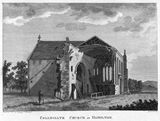 |
||||||||
| Hamilton Collegiate Church, Hamilton Low Parks, Hamilton, South Lanarkshire | ||||||||
 © RCAHMS |
Engraving of view by Francis Grose, 'The Antiquities
of Scotland' (volume 2, 1791) |
|||||||
|
This engraving shows the east end and associated north aisle of the largely demolished church as it stood at the end of the 18th century, evidently reduced to use as a store. It has clearly been an apsidal-ended structure of some grandeur with large traceried windows and lofty interior spanned by a braced timber roof. Entered through the round-headed arch on the north (left) side, the burial-aisle contained an elaborate monument to the 3rd Duke of Hamilton (1634-94) which, upon the final removal of the old church in about 1842, was re-mounted in Bothwell Parish Church. A block plan by the architect David Hamilton (1768-1843) shows the precise position of the old church and vault in relation to the palace in about 1838 when plans for a new mausoleum were beginning to be formulated. This engraving is one of many views published by Captain Francis Grose (c.1731-91) who, following a career as an antiquary in England and Wales, towards the end of his life embarked upon a comparable survey of the antiquities of Scotland, an enterprise which, among other things, brought him into close friendship with the poet, Robert Burns. |
||||||||
|
|
|
|
|
|
|
|
|
|
 Isaac
Miller drawing, c.1677 Isaac
Miller drawing, c.1677 |
||||||||
|
|
|
|
|
|
|
|
|
|